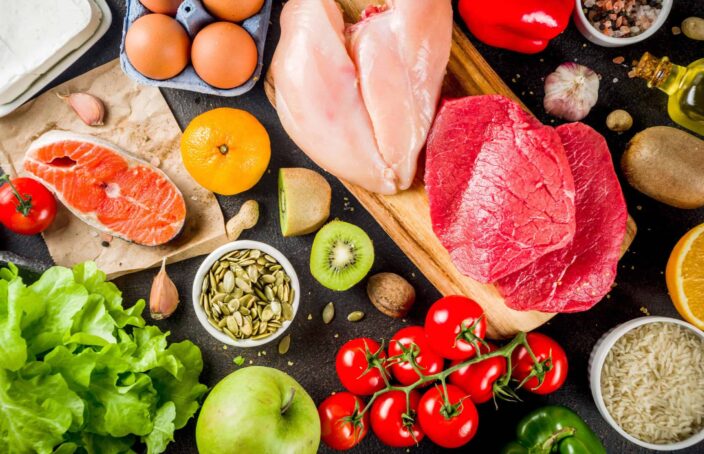Top 7 IBD Diet Tips (For Instant Relief)
Living with Inflammatory Bowel Disease (IBD) can be challenging, especially when it comes to managing symptoms like abdominal pain, bloating, and fatigue. As someone who has spent time learning about digestive health, I understand how important it is to find dietary strategies that can help ease discomfort. While there’s no one-size-fits-all IBD diet plan, there are certain foods and habits that can make a big difference. Here are seven effective diet tips that can help provide symptom relief and support a healthier, happier gut.
1. Embrace a Low-Residue Diet
When experiencing an IBD flare-up, a low-residue diet can be particularly helpful. This diet limits high-fiber foods that add bulk to your stool, which can reduce the frequency and size of bowel movements. By eating low-residue foods, you can give your digestive system a break and reduce irritation.
How to Do It:
- Focus on low-fiber options like white rice, pasta, cooked vegetables, and skinless potatoes. These foods are easier on the digestive tract and produce less waste.
- Avoid seeds, nuts, and whole grains as these can aggravate symptoms during a flare-up.
- Stick to peeled fruits and well-cooked veggies to minimize fiber intake while still getting essential nutrients.
Why it works: Low-residue foods are easier to digest, reducing the strain on the intestines and helping to minimize symptoms like diarrhea and abdominal pain.
My experience: The first time I tried a low-residue diet during a flare-up, I was amazed at the relief it brought. Foods like rice and cooked carrots became my comfort foods. I felt more comfortable, less bloated, and it made a big difference in how I managed my symptoms. This diet has since become a regular part of my IBD diet plan during flare-ups.
2. Cook Your Vegetables
Raw vegetables can be tough on the digestive system, especially if you’re dealing with IBD. Cooking vegetables helps break down their fiber content, making them easier to digest. Steaming, boiling, or roasting vegetables allows you to enjoy their nutrients without causing unnecessary strain on your digestive tract.
How to Do It:
- Choose gentle cooking methods like steaming or boiling for a soft texture that’s easy to digest.
- Stick to low-fiber veggies like carrots, zucchini, and squash. Avoid cruciferous vegetables like broccoli and cauliflower, which can be harder to digest and may cause bloating.
- Consider pureeing cooked vegetables to make them even gentler on your digestive system.
Why it works: Cooking vegetables reduces their fiber content, making them easier for your body to process. This can help prevent bloating, cramping, and irritation associated with IBD.
My experience: I used to eat a lot of salads, thinking they were the healthiest option. However, once I switched to cooked vegetables during flare-ups, I noticed my digestion improved significantly. Steamed zucchini and carrots are now my go-tos, and they keep my meals gentle on my stomach while still providing essential nutrients.
3. Eat Smaller, More Frequent Meals
Instead of three large meals a day, try eating smaller, more frequent meals. Large meals can put extra pressure on the digestive system and trigger symptoms. By eating smaller portions throughout the day, you can help your body digest food more easily and minimize discomfort.
How to Do It:
- Aim for 5-6 small meals or snacks throughout the day, rather than larger meals.
- Stick to simple, easy-to-digest foods like yogurt, applesauce, or a handful of plain crackers.
- Listen to your body and eat slowly, taking time to chew each bite thoroughly.
Why it works: Eating smaller meals reduces the amount of food passing through your digestive system at any given time, making it easier for your body to digest and absorb nutrients without overwhelming the intestines.
My experience: When I started eating smaller, more frequent meals, I noticed a big improvement. My energy levels were more stable, and I felt less bloated. Plus, it kept my digestive system from feeling overwhelmed. This has become a cornerstone of my IBD diet plan and has made eating more enjoyable.
4. Limit Dairy Products
Many people with IBD find that dairy products can trigger symptoms like gas, bloating, and diarrhea. While not everyone with IBD is lactose intolerant, limiting or avoiding dairy can provide symptom relief, especially during a flare-up.
How to Do It:
- If you’re sensitive to lactose, consider switching to lactose-free dairy options or dairy alternatives like almond milk, coconut yogurt, or lactose-free cheese.
- Try hard cheeses or Greek yogurt, which tend to be lower in lactose and easier to digest.
- Pay attention to your body’s response to different dairy products and adjust your intake accordingly.
Why it works: Lactose can be difficult to digest, particularly if you have IBD. Reducing your intake can help alleviate symptoms and make digestion easier.
My experience: Dairy used to be a big part of my diet, but I noticed that I often felt bloated and uncomfortable afterward. Switching to lactose-free and plant-based options has been a lifesaver. Almond milk and coconut yogurt have become my new favorites, and I feel so much better without the added discomfort.
5. Incorporate Healthy Fats
While a high-fat diet can aggravate IBD symptoms, it’s still important to get some healthy fats in your diet. These fats are essential for nutrient absorption and overall health, and they can provide a source of energy without stressing your digestive system.
How to Do It:
- Focus on healthy fats like olive oil, avocado, and coconut oil. These are easier to digest and provide anti-inflammatory benefits.
- Avoid fried foods and processed fats, which can trigger symptoms and contribute to inflammation.
- Add a drizzle of olive oil to steamed vegetables or mix avocado into a smoothie for an IBD-friendly dose of healthy fats.
Why it works: Healthy fats are gentle on the digestive system and help provide essential nutrients. Anti-inflammatory fats, like those found in olive oil, can help reduce inflammation and support gut health.
My experience: I used to shy away from fats, thinking they would make my symptoms worse, but healthy fats have actually made a positive difference. I love adding avocado to my meals and drizzling olive oil on my vegetables. It’s a small change that makes my meals tastier and gentler on my gut.
6. Avoid Trigger Foods
Everyone with IBD has different trigger foods, so it’s important to identify which foods tend to worsen your symptoms. Common triggers include caffeine, alcohol, spicy foods, and artificial sweeteners. By avoiding or minimizing these foods, you can help reduce flare-ups and keep symptoms in check.
How to Do It:
- Keep a food journal to track what you eat and note any symptoms that arise. This can help you identify patterns and figure out which foods are best to avoid.
- Limit carbonated beverages, as they can increase gas and bloating.
- Avoid spicy foods and artificial sweeteners like sorbitol, which can be hard on the digestive system.
Why it works: By avoiding foods that trigger inflammation or discomfort, you can help minimize symptoms and support a more balanced digestive system.
My experience: I learned the hard way that caffeine and carbonated drinks don’t agree with my system. Keeping a food journal helped me identify these triggers, and now I avoid them during flare-ups. I’ve found that this small adjustment really helps to keep my symptoms under control.
7. Stay Hydrated with Water and Electrolytes
Dehydration is a common issue for people with IBD, especially during a flare-up. Drinking plenty of water helps keep your digestive system running smoothly and supports overall health. If you’re experiencing diarrhea, you may also need to replenish electrolytes to prevent dehydration.
How to Do It:
- Aim to drink 8-10 glasses of water daily, and increase your intake if you’re experiencing symptoms like diarrhea.
- Incorporate electrolyte-rich drinks, such as coconut water, or try adding a pinch of sea salt to your water.
- Avoid caffeinated and sugary drinks, which can dehydrate you and worsen symptoms.
Why it works: Water helps maintain regularity by softening stools, while electrolytes are essential for maintaining fluid balance in the body, which is especially important for those with IBD.
My experience: Staying hydrated has made a big difference in managing my IBD symptoms. I’ve learned to keep a bottle of water nearby and often add a bit of sea salt or drink coconut water if I feel depleted. This simple habit has helped me stay energized and better manage flare-ups.
Bonus Tip: Work with a Nutritionist or Dietitian
IBD affects everyone differently, and finding the right dietary approach can be a process of trial and error. Working with a registered dietitian or nutritionist who understands IBD can provide you with personalized guidance, helping you identify the best foods and strategies for managing your symptoms effectively.
Conclusion
Managing IBD symptoms with diet doesn’t have to be overwhelming. By following these seven essential IBD diet plan tips, you can support your digestive health and find relief from discomfort. A low-residue diet, smaller meals, and hydration can make a big difference, while avoiding trigger foods and incorporating healthy fats can help reduce flare-ups. Remember to listen to your body and make gradual changes to see what works best for you. With the right approach, you can take control of your diet and experience symptom relief, one meal at a time.


